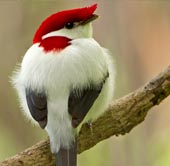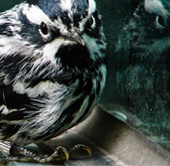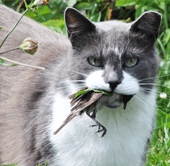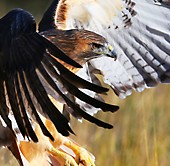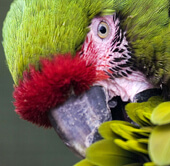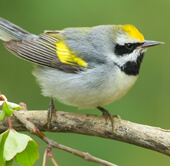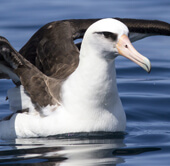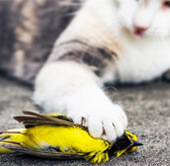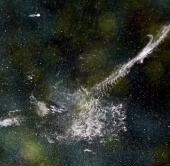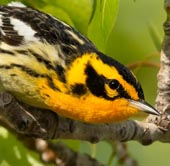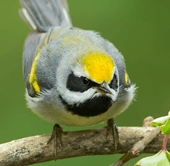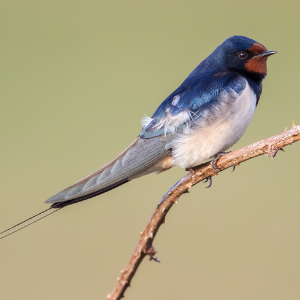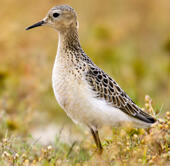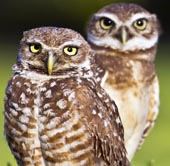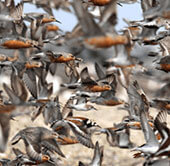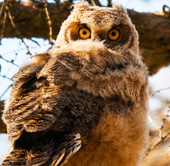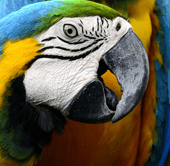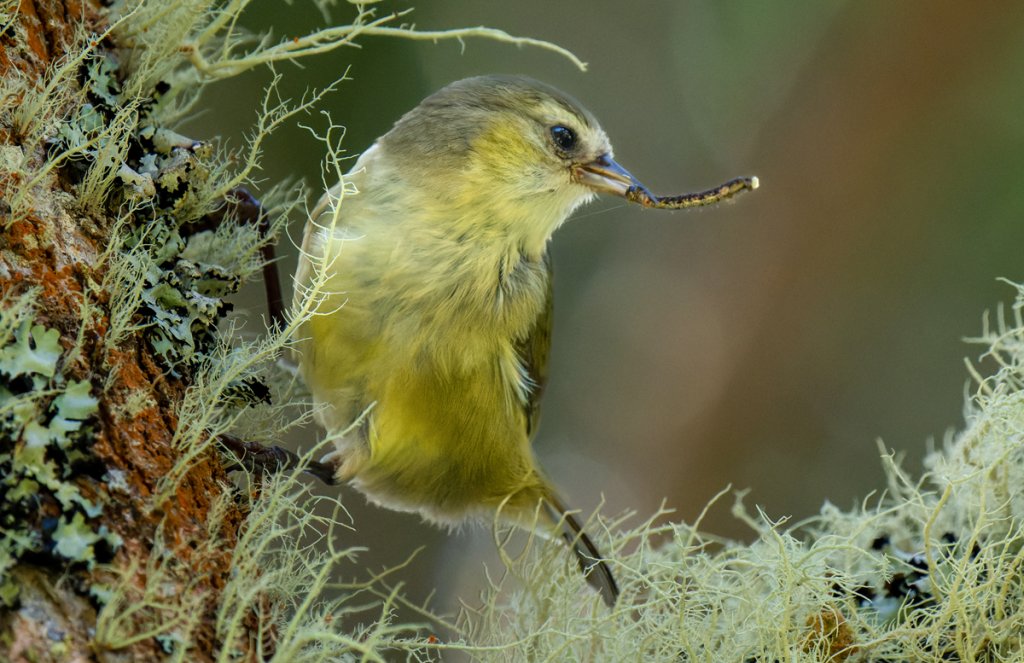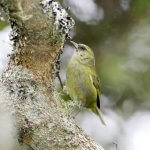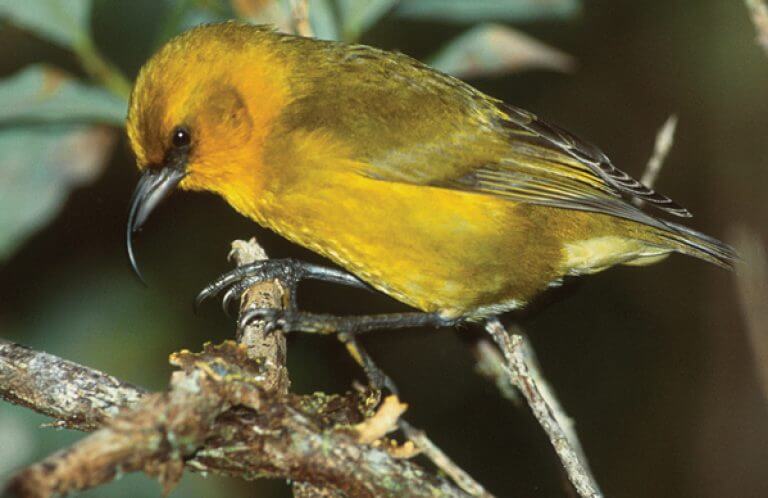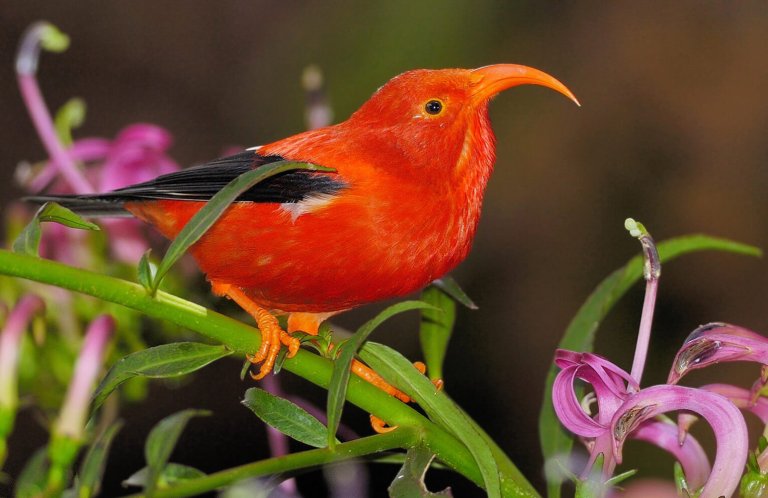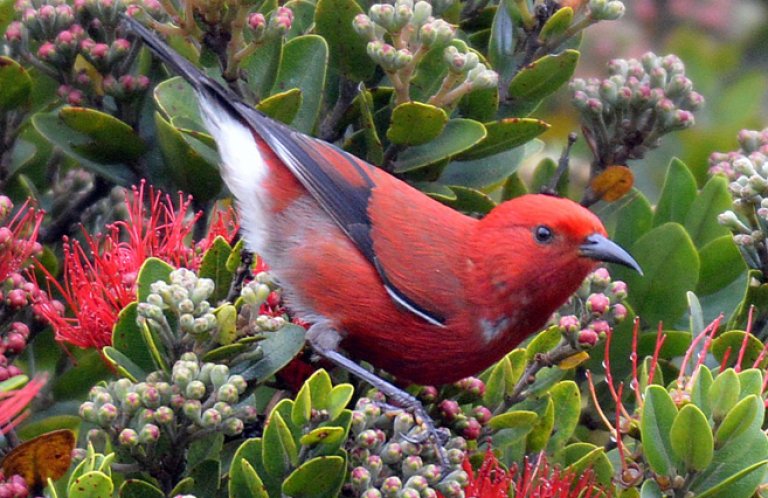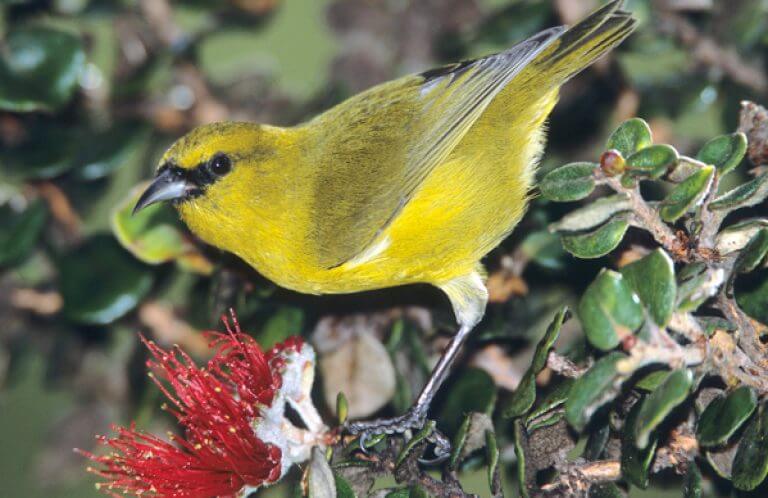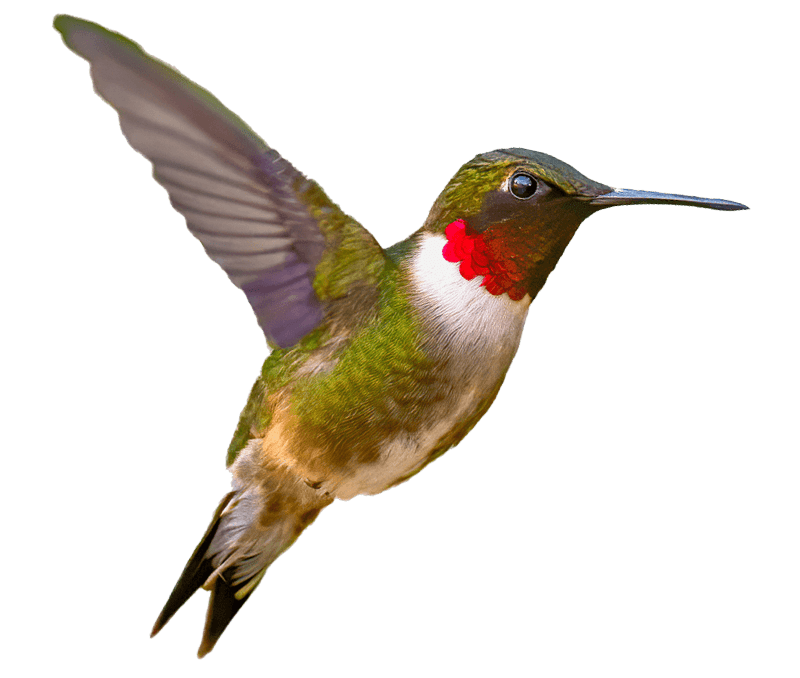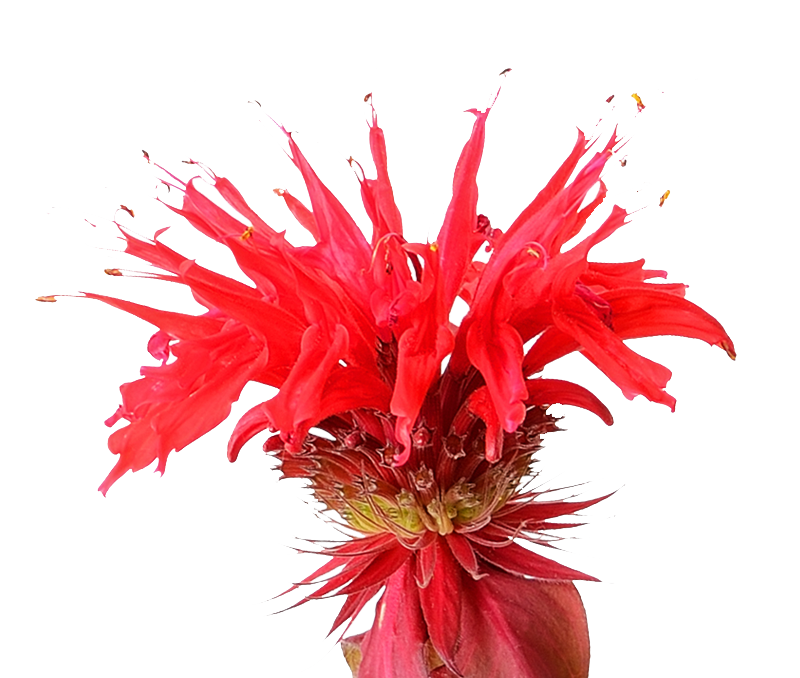About
The ʻAlawī is a small, inconspicuous Hawaiian honeycreeper, so unassuming in appearance that the first scientists who collected it didn't even realize that this bird was a unique species. In addition, researchers only made the connection between the Hawaiian name “ʻAlawī” and the bird described as the Hawai'i Creeper in 2017. The Kumulipo, the Hawaiian cosmological and genealogical chant, mentions the ʻAlawī as a “child” of the ʻAlalā (Hawaiian Crow), and other traditional Hawaiian epics refer to it as a small, quick bird.
While the ʻAlawī may lack the bright colors or unusual bill shapes or features of other native Hawaiian birds, this little honeycreeper is equally as interesting.
The ʻAlawī is somewhat similar to the more widespread Hawaiʻi ʻAmakihi, but has a broader mask and straighter, bi-colored bill, and behaves very differently as it forages through the trees. It occupies an ecological niche similar to that occupied by species such as the Brown Creeper and White-breasted Nuthatch, creeping up, down, and even upside-down along native trees as it uses its short, sharp beak to carefully probe for prey.
The male ʻAlawī is slightly more colorful than the female, with olive to bright-green upperparts, a grayish head, and a contrasting paler chin and throat. His undersides are pale bright yellow to olive-yellow, and wings and tail are dusky gray-brown. The male's most prominent field mark is a blackish mask that reaches from the base of the bill to the eyes (an area known as the lores) and extends around the eyes, ending at a point behind them. Female ʻAlawī have even more subdued plumage in shades of brown, gray, and light yellow, with a dusky, rather than dark, mask. Juveniles are duller yet, appearing largely grayish, with tinges of olive green, dull yellow, or buff.
Songs and Sounds
The song of the ʻAlawī is a descending trill described as dee-dee, dee-dee-dee, or jit-jit, jit-jit-jit; it usually sings several songs in succession. Only the males sing.
The ʻAlawī call is a soft squeet.
Song:
Call:
Breeding and Feeding
The ʻAlawī's breeding season lasts from February through June. During this season, pairs occupy a home range of 10 to 17 acres, defending a 33- to 66-foot territory around their nest.
Post-breeding, ʻAlawī and Hawaiʻi ʻĀkepa family groups become the core of mixed feeding flocks that include other native birds such as the ʻAkiapōlāʻau, Hawaiʻi ʻAmakihi, ʻIʻiwi, ʻApapane, and Hawaiʻi ʻElepaio.
The ʻAlawī forages in a distinctive creeping manner with its body held close to the tree bark. It works its way along tree branches in short, jerky movements as it quickly picks and probes for prey hidden under loose bark, moss, and lichen. It sometimes clings to the underside of a branch while foraging.
This honeycreeper is mainly insectivorous, gleaning spiders, spider eggs, insects, larvae, and eggs from the branches, trunks, and foliage of ʻōhiʻa and koa trees. It sometimes sips nectar from ʻōhiʻa flowers.
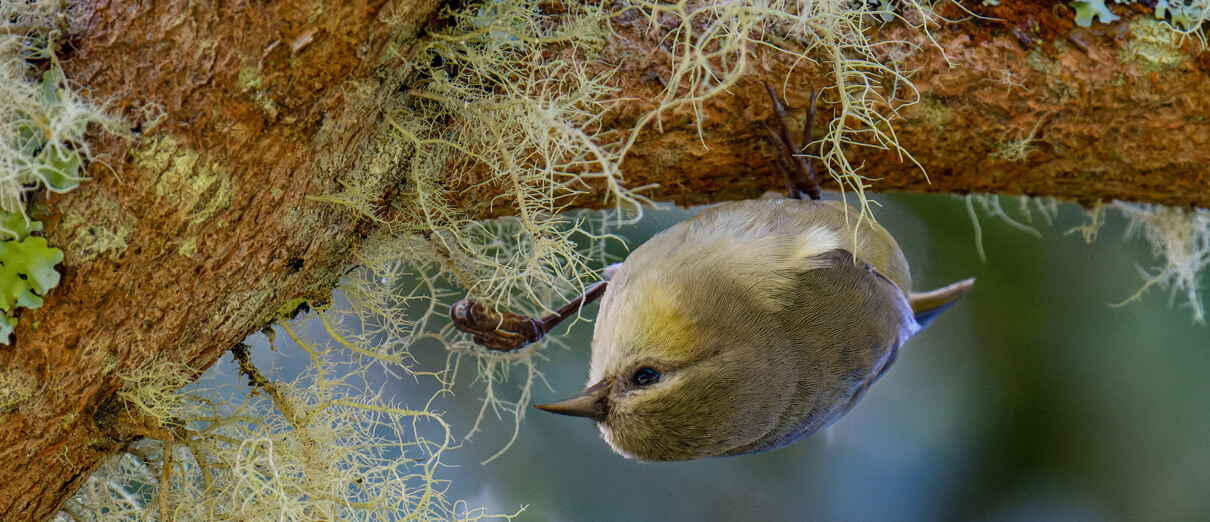
The ʻAlawī is socially monogamous and maintains long-term pair bonds. The male displays by “dancing” for his mate — uttering short, rapid bursts of single-noted calls as he hops to and fro or in place. He also brings his mate food during his courtship display.
The female ʻAlawī builds an open-cup nest of bark, rootlets, lichen, and moss, usually close to the trunk of a native koa or ʻōhiʻa tree. A small percentage of ʻAlawī nests are built in naturally-occurring bark crevices or tree cavities.
The female ʻAlawī lays a clutch of one to three (typically two) eggs, and incubates them herself, while her mate delivers food. The eggs hatch after around 13 days, and both parents feed the chicks. The female continues to brood the nestlings, and both parents feed the young for about a month. After fledging, juveniles remain dependent on their parents for another four to six weeks. Both parents continue to feed their young during that time.
ʻAlawī will re-nest after nest failures, and a pair may raise two sets of offspring in a season. Although nest success is very low, adults have a high annual survival rate.
Region and Range

The ʻAlawī occurs in four disjunct populations: on windward Hawaiʻi, and in the Kaʻū, Kona, and Hualālai regions.
ʻAlawī are sedentary (nonmigratory) and show strong site fidelity throughout the year and between years.
Conservation
Logging of native forests and introduced ungulates such as pigs, cattle, goats, and sheep have destroyed and degraded forest habitat for the ʻAlawī. Habitat fragmentation may also prevent natural recolonization of its former range.
Diseases such as avian malaria and pox introduced by non-native mosquitoes have decimated ʻAlawī populations. ʻAlawī nest success rates are very low, at least in part due to predation of eggs and chicks by introduced species including rats. Invasive species also threaten the ʻAlawī by competition for prey.
Rising global temperatures will allow disease-carrying introduced mosquitoes to spread into higher elevations, further reducing the ‘Alawī's range. In addition, climate change will exacerbate the effects of habitat loss and allow invasive plants to spread into new areas.
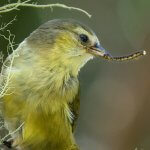
Help support ABC's conservation mission!
Fencing and removal of non-native livestock are critical conservation actions being used at Hakalau Forest National Wildlife Refuge, the first refuge established solely for native Hawaiian forest birds such as the ʻAlawī.
ABC belongs to a multi-agency partnership, Birds, Not Mosquitoes, that is deploying non-biting, lab-reared male mosquitoes carrying a naturally occurring bacteria that results in sterile eggs when the released males mate with wild females. With time, the population of invasive, malaria-carrying mosquitoes will be reduced in Hawaiʻi.
ABC and our partners work on an ongoing basis to advocate for the protections and resources Hawaiʻi's birds need to ensure their survival. We pursue policy solutions at the state and federal levels in the United States that support work to conserve and regenerate habitat, remove the threats posed by introduced species, establish new populations of vulnerable species, and develop and implement innovative tools to prevent further extinctions. Learn more about the urgent issues impacting birds in Hawaiʻi and throughout the Western Hemisphere and take action.
Get Involved
Policies enacted by the U.S. Congress and federal agencies have a huge impact on Hawai'i's birds. You can help shape these rules for the better by telling lawmakers to prioritize birds, bird habitat, and bird-friendly measures. To get started, visit ABC's Action Center.
Our Hawaiian partners frequently need help with habitat restoration and other projects benefiting birds. If you live in or will be visiting Hawai'i and would like to volunteer, check the following Facebook accounts for opportunities: Kaua'i Forest Bird Recovery Project, Maui Forest Bird Recovery Project, and Mauna Kea Forest Restoration Project.
American Bird Conservancy and local partners are restoring forests, protecting critical habitat, and much more to save native Hawaiian birds. This is a monumental undertaking, requiring the support of many, and you can help by making a gift today.

